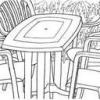Town planning - why long, narrow residential plots make sense.

When you are in a back garden and look around, the proportions seem ‘about right’, but what is striking when you look at maps is how narrow and long most residential plots of land actually are.
The terraced house we lived in in London Zone 3 was on a plot about 6 yards wide x 30 yards deep. We’re now out in the wilds of Zone 5 and our house is on a plot 9 yards x 40-45 yards deep (not really sure). The semi in which I grew up (fairly nice commuter suburb of Leeds) was somewhere in between. This is a ratio of about 5:1 depth to width, which I think is actually about normal for urban and suburban areas (terraced and semi-detached houses).
(Interestingly, our new house would sell for a bit more than the previous one, but if we adjust for the extra cost of the larger building, the net land value is about the same. So land values per square yard are about half as much for being twice as far from ‘the centre’ = Von Thünen’s Law of Rent).
Using the brute force of Excel, and assuming
- an average residential plot is one-tenth of an acre,
- a residential road is about 8 yards wide,
we can multiply to work out the total amount of land you need to build a certain number of houses in a ‘row’ (with roads along the front and down the side of each end house), with the variable being plot width/depth.
Divide the total amount of land (plots plus roads) by the number of homes, and the lowest average total amount of land per home is *the optimum* for the purposes of this post.
Utility connections usually run along the front, the narrower the plot, intuitively, the cheaper it is to service all those houses with water, electricity, gas, broadband/telephone etc, although I didn’t adjust for that as requires too many assumptions. This means that the economically optimal answer is probably slightly narrower plots widths than the spreadsheet says.
A few things stand out:
1. The more homes you have in one row, the less land you need overall. This should be pretty obvious – however many houses there are in a row, the amount of side road is fixed purely by the depth of the plots.
2. The more homes you have in one row, the narrower the optimum plot width (and the deeper the plots). So if you want to build homes in rows of ten, the optimum plot width is 10 yards (48 yards deep). If you want to build homes in rows of 20, the optimum is 7 yards wide (and 69 deep). This is because an extra house in the block means more front road but does not add to the amount of side road.
NB: I assume that most people don’t value back gardens beyond a certain size. The first 50 square yards are essential, just enough for the bare essentials of a patio, a washing line and a sand pit/paddling pool for the kids. Get past 200 square yards or so and it’s wasted and more bother than it’s worth. Also, the further the land is from the house the less it is ‘worth’ to the occupants. I didn’t adjust for that as it involves too many assumption – clearly a back garden 6 yards wide and 60 yards long is just daft. So I suppose there is a natural cap on the depth and/or the depth:width ratio, which appears to be about 5:1.
3. The optimum width is narrower in urban areas (more homes in a row, smaller plots) and wider in suburban areas (fewer homes in a row, larger plots), and with sensible inputs, plots are 5 yards wide for the former and 10 yards wide for the latter. This sort of makes sense. 5 yards is wide enough for a narrow terraced house and 10 yards is wide enough for a semi-detached house with a drive/car porch at the side. In either case, the depth: width ratio is about 5:1.
Which all leads to lots of other interesting musings, such as having council set maximum or minimum densities or plot sizes is pretty futile, these things will happen of their own accord if developers want to maximise profits/minimise amount of land used. Or that land valuations could be carried out by simply measuring frontage and assuming that most plots are the optimum depth anyway.
Source: http://markwadsworth.blogspot.com/2018/03/town-planning-why-long-narrow.html
Anyone can join.
Anyone can contribute.
Anyone can become informed about their world.
"United We Stand" Click Here To Create Your Personal Citizen Journalist Account Today, Be Sure To Invite Your Friends.
Please Help Support BeforeitsNews by trying our Natural Health Products below!
Order by Phone at 888-809-8385 or online at https://mitocopper.com M - F 9am to 5pm EST
Order by Phone at 866-388-7003 or online at https://www.herbanomic.com M - F 9am to 5pm EST
Order by Phone at 866-388-7003 or online at https://www.herbanomics.com M - F 9am to 5pm EST
Humic & Fulvic Trace Minerals Complex - Nature's most important supplement! Vivid Dreams again!
HNEX HydroNano EXtracellular Water - Improve immune system health and reduce inflammation.
Ultimate Clinical Potency Curcumin - Natural pain relief, reduce inflammation and so much more.
MitoCopper - Bioavailable Copper destroys pathogens and gives you more energy. (See Blood Video)
Oxy Powder - Natural Colon Cleanser! Cleans out toxic buildup with oxygen!
Nascent Iodine - Promotes detoxification, mental focus and thyroid health.
Smart Meter Cover - Reduces Smart Meter radiation by 96%! (See Video).





